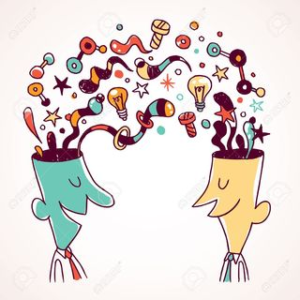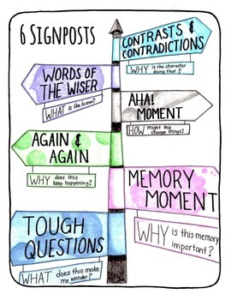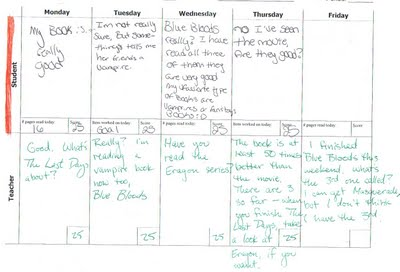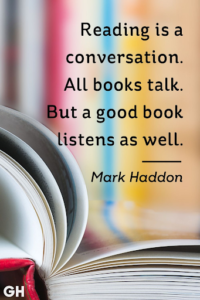This week’s post comes to you from Kim Hollis. Kim is a reading specialist at Geneva Middle School South! I am thrilled to share her post with you as it provided me with an interesting take on reading comprehension that I had never thought of before!
Recently I had the pleasure of meeting some friends, who are also colleagues, after work for some sweet treats and socialization. We chose to meet at All Chocolate Kitchen in Geneva with the intent to catch up with each other since the start of the school year has been so busy for all of us. I went assuming we’d gather for about an hour or so, and I’d get home in time to make dinner for my family. We ordered our treats, found a comfy corner to sit in, and started chatting. We chatted about a plethora of topics – from our families, to pets, to challenges we faced, to work stories. We laughed — a lot. We listened intently and we connected. Before we knew it, three hours had passed, and I was long past getting home in time to make dinner for the family.

As I drove home, guiltily visiting a drive-through so as not to arrive home empty handed, I started thinking about how easy it was for us to engage in that long conversation. Of course, we care about each other and are invested in each other’s stories…but, that doesn’t mean we agree on everything – nor do we have to. Our conversation kept going because we listened with intention to each other. We connected or related to the stories told. We asked questions to clarify or get more details. Above all, we were open to learning new things from each other.
As I kept thinking, I realized how these are the same ways we engage when reading. Reading and comprehending involve just that – engaging in a conversation with the writer of the text. To keep the conversation going, we ask questions of the author, and we make connections as a means of relating to the information in the text – whether a fictional story or an informational text. When we lose the train of thought, we ask clarifying questions and try to re-engage in the conversation. The point is that the back and forth of the conversation is how we make sense of a text. This analogy is one I have used with my students in the past. They understand how having a conversation takes two (unless you’re talking to yourself, which happens more often than we’d like to admit 😊), so applying this analogy to reading helps students understand that they play a role in the conversation. They have to be actively engaged.

This is not a new idea. Literacy gurus the likes of Cris Tovani and Kylene Beers in their work with breaking down comprehension strategies for students hit on this idea of interaction with text. The signposts from Notice and Note by Beers & Probst are simply a way to focus that conversation and provide access points for students to join the conversation. The same is true of Tovani’s strategies of thinking through and annotating text by visualizing, questioning, or making connections. In her book So What Do They Really Know, she shares a strategy called a conversation calendar where students share their thinking about a text (their internal conversation) and she responds back to them. This activity makes the conversation with text more concrete for students, so they engage more easily, and the teacher essentially becomes a ‘real’ stand-in for the author. This makes total sense when breaking down the idea for students because having a conversation with a text is abstract. However, the idea of having a conversation is an easy thing to relate to and define.

So, if you’re trying to figure out how to teach students to metacognitively think about comprehension, try starting by discussing what makes conversation meaningful. Students will come up with things like my story above – listening intently, asking questions, making connections. Then, show students how we do these things when we engage with a text…that engagement involves having a ‘conversation’ with the text. Give them strategies, like the old Mosaic of Thought thinking strategies, annotation, conversation calendars, and Notice and Note strategies, to use when they don’t know how to keep the conversation going – either because they are not interested or because they are not familiar enough with the topic. These strategies serve as entry points to the conversation. Students need to see the process as an active thing their brains engage in, not something passive that happens to them as their eyes move across the page. The conversation analogy gives them a concrete way to think about this interaction. With these strategies, maybe students can get lost in a book like we get lost in conversations with good friends.
________________________
1“Conversation Calendars – “So What Do They Really Know” by Cris ….” http://sowhatdotheyreallyknow.blogspot.com/2013/02/conversation-calendars.html. Accessed 25 Oct. 2021.

I want to again thank Kim for sharing her knowledge with us through her writing. If you would like to be a guest writer for “The Progress Report” please reach out to me (Katie) so we can arrange this. We all have something we can learn or take away from one another so please consider being a guest writer, such as Kim has.
Katie Algrim – Director of Innovative Professional Learning
(t):630-444-3044
(c):630-675-4447
(e):kalgrim@kaneroe.org
